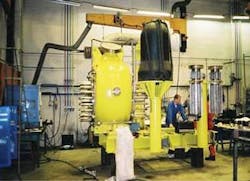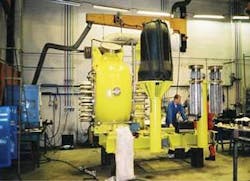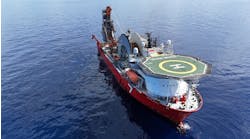Huhnseal is supplying mechanical seals for the multiphase booster pumps to be installed on BP’s King field in the Gulf of Mexico. The reference is a groundbreaking one, as the installation depth for the equipment, at 1,645m, will be the deepest to date for any multiphase pump; at 29-km, the tieback distance over which the wellstream will be pumped will also be the longest.
The differential pressure over the seal faces, which are made of silicon carbide, will be 20 bar. Huhnseal’s customer is the pump manufacturer Bornemann. The pumps stations are being supplied to BP by Aker Kvaerner. Altogether three pumps will be supplied, one of them a spare.
The seals will be installed where the shaft passes through the pump casing, separating the clean oil lubricating the electric motor and transmission from the multiphase flow of oil, gas, water and sand. They are critical components, as any leakage would cause the breakdown of the pump, according to Göran Anderberg of Huhnseal.
Huhnseal has previous experience with multiphase projects. Onshore Canada several smaller multiphase pumps (a new design) from Bornemann have been installed to boost oil field production. The pumps are installed in a container complete with all instrumentation.
The company also supplied the seals for the five subsea pumps supplied by Framo Engineering to Statoil’s Lufeng 22-1 development off China, the first such application subsea. Installed in 1997 in a water depth of 320m, these pumps operate at 40 bar, pumping the production stream from the wells a short distance to Navion Munin, the Lufeng FPSO. When the FPSO has to disconnect because of a typhoon alert, the subsea system is pressurized to 200 bar before the submerged turret is dropped to 40m below the sea surface. This puts added strain on the seals.
The pumps were retrieved when the Lufeng Field was temporarily closed down in 2004 and the seals returned to Huhnseal for service. They were in good condition, Anderberg says. The seal faces were relapped and the elastomer rings changed out. The pumps are back in operation on the field following reinstallation in 2005.
Material development
Huhnseal seals are also installed in two Bornemann multiphase booster pumps which are in pilot operation at an onshore location for Adco in Abu Dhabi. Here the seals are subject to 60 bar pressure. The pumps and diamond/coated seals have been working satisfactorily since they came into operation in 2003, Anderberg says. The seal face diamond coating was developed in association with the Ångström Laboratory in Uppsala, Sweden. Huhnseal now has access to this technique under an exclusive license.
The advantage of diamond coating is that friction is reduced drastically during pump operation. Less heat is therefore generated, which means that the seal face is exposed to less stress.
There are still limitations with the use of silicon carbide for the body of the seal, as it is relatively brittle and liable to crack under stress. Huhnseal is therefore in the early stages of a new project with the Ångström Laboratory to develop a stronger material using a different sintering process. A number of other partners with the relevant expertise have signed up for the project, which is expected to take 18 months. The manufacturing processes involved are suitable for making ceramic composite materials, which could be a possible solution.
“We’re looking to get higher performance at higher pressures and higher speeds,” says Anderberg. He is surprised, he adds, that more work has not been done by the industry to develop ceramics for different applications, especially in view of high steel prices. Huhnseal has previously carried out work with ceramics specialist AC Cerama to develop such materials, which are manufactured using the hot isostatic pressing (HIP) method.
While seal rings made in tungsten carbide and silicon carbide tend to break up at 10-25 bar in a special test machine, the AC Cerama materials were successfully tested at up to 45 bar, and with diamond coating at up to 70 bar.
Elsewhere, Huhnseal is working with engineering company Rotech to develop technology for demanding applications in drilling and downhole pumping and wash-pipes, using a new turbine-driven gearbox. A test program has been run in Houston. “Breakdowns in these types of operations are very costly, so if we can come up with good solutions, we will save the users money,” says Anderberg.
The company has supplied diamond-coated seals to pump manufacturer DiscFlow for use in slurry pumps for pumping drilling mud and cuttings. A number of such pump installations are in operation in Azerbaijan. It has bid to supply its seals for a planned installation involving three slurry pumps in series pumping mud and cuttings from the seabed in 600m water depth.
Huhnseal’s products are also to be found in heavy-duty applications involving sand. Various deliveries of seals, some diamond-coated, have been made to Metso for use in slurry pumps cleaning sand contaminated with oil before it is returned to the sea. Diamond-coated seals are also installed in a Rowco water-jet system used for seabed cable-trenching.
For more information contact Göran Anderberg, Huhnseal. Tel +46 418 449942, fax +46 418 449969,[email protected], www.huhnseal.se




